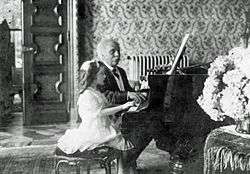Piano duet

According to the Grove Dictionary of Music and Musicians, there are two kinds of piano duet: "those for two players at one instrument, and those in which each of the two pianists has an instrument to him- or herself." In American usage the former is often referred to as "piano four hands".[1] Grove notes that the one-piano duet has the larger repertory, but has come to be regarded as a modest, domestic form of music-making by comparison with "the more glamorous two-piano duet".[2] The latter is more often referred to as a piano duo.[3]
The piano duet came to popularity in the second half of the 18th century. Mozart played duets as a child with his sister, and later wrote sonatas for four hands at one piano; Schubert was another composer who composed for the genre, notably with his Fantasy in F minor, D. 940. Jane Bellingham in The Oxford Companion to Music lists other composers who wrote piano duets, including Brahms, Dvořák, Grieg, Debussy, Stravinsky, and Bartók.[3] In the late nineteenth and early twentieth centuries French piano duets included Bizet's Jeux d'enfants, Fauré's Dolly Suite and Ravel's Ma mère l'oye.[2]
References
- ↑ Kuhn, Laura Diane; Nicolas Slonimsky (2001). Music since 1900. New York: Schirmer Reference. p. 81. ISBN 0028647874.
- 1 2 Dawes, Frank. "Piano duet", Grove Music Online, Oxford Music Online, accessed 31 March 2012 (subscription required)
- 1 2 Bellingham, Jane. "piano duet", The Oxford Companion to Music, Ed. Alison Latham, Oxford Music Online, accessed 31 March 2012 (subscription required)